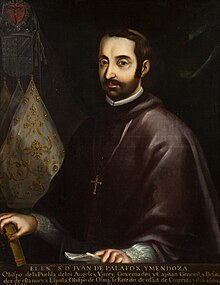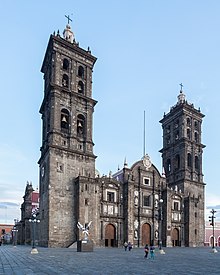Puebla Cathedral
In 1543, the construction of a temple for the new episcopal seat was approved by real cédula of Carlos V, Holy Roman Emperor which received the new bishop Friar Martín Sarmiento de Ojacastro since Garcés had died the previous year.Since its foundation, the Spanish colony had been projected to form a set of rectangular blocks, in which a large central space was reserved for said plaza and another one was left next to it, which after the first years of uncertainty about its use became it would become a major church.Construction began on August 29, 1535, with the financial help of Bishop Ojacastro and settlers from the city where the first stone was laid, with the assistance of Corregidor Hernández de Elgueta and Mayor Alonso Martín Partidor.The initial architect was the Spaniard Francisco Becerra, designated major master, together with Juan de Cigorondo, senior worker, who prepared the layout and model as well as the interior and exterior, showing them to the Dean and the Cathedral Chapter and, upon approval, they were given the land and instructions for laying foundations.The arches are of double proportion with their imposts, jambs and bands that garnish them, breaking these on the pedestal and secured with stonework balustrades, being all of this first body eight, the space between these and the cornice, is divided by a strip, the rest being bossage.This portal is divided into three bodies: the first of the Doric order with four fluted half columns with their pedestals and cornice, in the intercolumns there are two well-crafted niches, with two stone statues of Villería, one of Saint Peter with book and key; and that of Saint Paul with the sword, in the middle the Puerta del Perdón whose impost runs above the niches and between it and the cornice there are some shields of Villería with the shields of the cathedral: a vase of lilies, symbol of the Immaculate Conception of Mary.The third body consists of two fluted Doric half-columns on pedestals and its cornice without pediment is topped with the arms of Spain, which from 1827 to 1930 was covered with mixture with the intention of putting the Mexican shield, however, and finally the place bears the Mary's monogram but keeping the golden fleece and the royal crown.The portal facing North (Norte) is approximately 30 meters high, consists of three bodies, the first is of the Doric order with four fluted columns and its capitals with carved ovos in its fourth bocel, finished off with well-proportioned cornices without triglyphs; in the intercolumnios there are ledges with well-defined niches topped with shells and in it there are two statues of Saint John the Evangelist and Saint Matthew the Apostle, life-size and of Villería; the impost of the arch runs to the sides, there are also medals with portraits of founding kings in low relief and white stone and of the same some children that adorn the spandrels of the arch.It is half orange and rises majestically over the crossing, its octagonal basement with three Ionic pilasters at each angle and on its cornice on the four front walls there are as many windows, the exterior surface included a coating of yellow and green azulejos of terracotta in whose three quarters shine the same number of stars distributed at equal distances, and ends with a graceful cusp and a statuette of the Conception.Once these buildings disappeared according to a plan of 1754, a new chapel was built for the natives and at their expense, this time on one side of the south tower, it had the shape of a barrel made up of four vaults, its measurements are 6 m. high, 7.5 wide, and 15 m. long and was dedicated to "Las Lágrimas de San Pedro".All the pillars carry the weight of forty vaults and two domes, all of which are made of gray quarry stone that was brought from the neighboring towns of the city and carved with such precision that the work seems error-free.The altar table has a silver front and supports a tabernacle more than a meter high made of the same metal, with a niche in the middle where a Christ by José Antonio Villegas Cora is placed, and others on the sides with various relics.Through the access on the north side of the transept there is a large-format oil painting of Saint Christopher carrying the Child Jesus and in front of it is the archangel Michael by the 18th-century painter Luis Berrueco.The chapel was designed by the Spaniard Juan Martínez Montañés and its main altarpiece in Solomonic Baroque style was the work of master Lucas Méndez under the direction of Pedro García Ferrer, and inspired by a sketch by Sebastián de Arteaga, it was consecrated on April 18, 1649. by Bishop Palafox and its factory lasted seven years.The fourth body and auction is made up of the oil painting of the Coronation of the Virgin Mary by the Holy Trinity placed between paired columns of the compound order, the large central space is made up of the second and third body with Solomonic columns, it is occupied by the oil painting of the Assumption of Mary, on the left side intercolumns Edward the Confessor and Ferdinand III of Castile on the right side Helena of Constantinople, mother of Emperor Constantine, and Margaret Queen of Scotland.The first body is made up of square pilasters and Ionic capitals and in each intercolumnium the sculptures of Louis IX of France and Saint Elizabeth, Queen of Hungary, in the middle part of this body is the Tabernacle with four Solomonic columns, in the glass niche there is the image of Our Lady of Defense on a base and silver column, in the collaterals of this tabernacle there are two oil paintings: the birth of the Child Jesus where the 9th bishop of Puebla Juan de Palafox y Mendoza is represented and the adoration of the Saints Magi Kings.It is a Neoclassical style building with the influence of ancient Roman architecture of its time of decline, which involves volumetric searches breaking into complicated entablatures and pediments to the counterpoint of straight lines and curves, in this monument there is a wide variety of materials such as Tecali marble, stucco, bronze, brass and cedar wood in the crypts.The cornice is interrupted in each section of the pillars to house in its gaps large gleams with the anagram of the Virgin Mary and stucco finials of angels, on the dome a Saint Peter surrounded by seraphim and clouds in white stucco finishes off, the lower part it was decorated in a very sumptuous way in keeping with the rest of the monument, the building leaves a large hollow space for the tabernacle and the Immaculate Conception, it is classified by means of a stepped plinth with eight sides that mark corner pilasters and have gilded doors in their openings, it is closed by a better half and culminates with the statue of the Immaculate Virgin who steps on the biblical serpent in the clouds, it was cast in bronze and weighs 920 kilograms.The Choir is made up of three large walls that open in the shape of a horseshoe in the direction of the high altar, the space it creates is closed by a 17th-century wrought Pueblan iron gate by master Juan Mateo de la Cruz that ends with the Calvary in ivory and in the collaterals, the bell towers.The so-called International organ has a total of 3376 pipes or musical sounds, it is electro-pneumatic based on turbines and electricity, the largest tube measures 12 m and the smallest 1 cm, it plays on big occasions such as weddings, graduations, concerts, etc.Of the three organs, the two old ones are no longer in service since they stopped working at the end of the 19th century and they were never sent to restore since the chapter wanted to preserve them as artistic relics or decorative jewels, testimonies of the historical and religious trajectory of the cathedral.José Manzo, who was in charge of transforming the Baroque decoration of some spaces of the cathedral into the Neoclassical style, placed the painting of the famous Oaxacan Miguel Cabrera of The Virgin of Guadalupe, already made in 1756 in her new altarpiece, accompanied by images of the Blessed Bartolomé Gutiérrez and Saint Philip of Jesus, martyred in Japan.Here again José Manzo intervened for the redecoration in the Neoclassical style by removing the Baroque altarpieces and thus consecrating it to (María Salus Infirmorum) "Mary health of the sick" whose painting was the work of the Pueblan master Francisco Morales Van den Eyden.The chapel "del Cristo", as it was formerly called because of the magnificent life-size sculpture of the crucified Jesus, which according to legend was said to have been made in Europe and blessed by Pope Paul VI, said without support, since the piece is made of corn cane paste, a raw material from the state of Michoacán, possibly brought by Bishop Antonio Ruíz de Morales y Molina, who ruled the diocese from 1572 to 1576, the sculpture is accompanied on the sides by a Virgin of Hope and a Saint John the Baptist, both by Master Lugardo.The walls of the following vault are also covered with large-format canvases: In the front interspace, in a Churrigueresque-style painting, the "Immaculate Conception stands out under the patronage of the bishops of the Diocese of Puebla", beside it stands Friar Julián Garcés first bishop and Juan de Palafox y Mendoza to conclude the works of the cathedral, this beautiful canvas was painted by Luis Berrueco, and in the blades of its half point, the apparitions of Our Lady of Pilar to Saint James and Saint Ildefonsus.In this room, 4 tapestries (Gobelins) from Greek mythology shine in all their magnificence, representing Queen Hippolyta of the Amazons on the banks of the Termodont who was defeated by Heracles, the chariot of the aurora excels as a nurse of nature and the encounter of Thalestris and Alexander the Great Generalissimo of the Hellenes.Also known as the Hall of Bishops, it was carved with a certain amount of stone, it was originally covered with “expensive moldings in the manner of those of Mexico, with ribs, an enclosure that was modified by groin vaults made of flagstone and brick.This chapel is in the Baroque style of the 17th century, it was a small oratory and deposit, today reduced to its minimum expression and disuse, the oil paintings alternate with framed and embroidered reliquaries, they are works by Cristóbal de Villalpando.It was designed on an octagonal floor plan then called Ochavada enclosed in a box of almost 10 m per side with walls of 7.30 m high to the base of the dome which is covered with bricks and finished off with a lantern with Talavera decorations ending in an iron weathervane.One of the beautiful lamps that hang from the largest dome, the second in size, is a masterpiece by the goldsmith Diego Larios, it was premiered on Corpus Christi in 1751, it is a work they call Mestiza because it is made of silver with gold overlays, he maintains 42 lights.


























AffiliationRoman CatholicDistrictArchdiocese of Puebla de los ÁngelesEcclesiastical or organizational statusCathedralMinor basilicaYear consecratedPuebla de ZaragozaGeographic coordinatesArchitect(s)Francisco BecerraManuel TolsáPedro García FerrerCristóbal de VillalpandoHerrerian styleNeoclassicalBaroqueUNESCO World Heritage SiteHistoric Centre of PueblasessionLatin America and the CaribbeanImmaculate ConceptionMarian invocationhistoric centerPueblaWorld Heritage SiteUNESCOMetropolitan of MexicoPhilip II of SpainHerrerian-stylePhilip IIPhilip IIIPhilip IVJuan de Palafox y MendozaNew SpanishIsabella of PortugalCarlos V, Holy Roman EmperorReal AudienciaTlaxcalaJulián GarcésCabildoAntonio de Mendozareal cédulaMonzónCholulaBattle of PueblaÁlvaro Manrique de ZúñigaMexico City Metropolitan CathedralPalafoxtithesJesuitsBlessed SacramentPalafoxian LibrarychancelmarbleGreek crossSt. Peter's BasilicaCharles II of SpainFrancisco Fabián y FuerotowerscorniceDoric orderpilastersarchesintercolumniumpedestalsarchitravefriezetriglyphsmetopesimpostsbalustradesbossageIonic orderplinthmerlonsazulejosroof lanternArmy of the Three GuaranteesAgustín de IturbideRenaissancecolumnsnichesSaint James the Greatpedimentgolden fleecePius XSaint Rose of LimaSaint Teresa of Ávilareligious ecstasySaint ChristophercapitalsintercolumniosSaint John the EvangelistSaint Matthew the ApostlespandrelsSaint LukeSaint MarkpendentivesstuccoMichaelGabrielRaphaeltumbagacrossingbullfightsossuarybarrelvaultsAguadoresTuscan columnsparallelogramfaçaderosettescoffersfleuronsmedallionspumiceMiguel CabreraJosé Zacarías CoraSaint JosephArchangel MichaelJoachimSaint AnneStations of the Cross